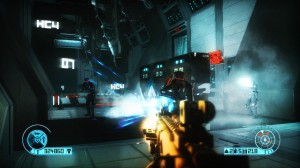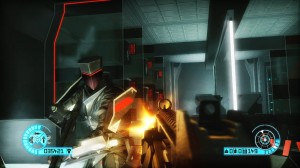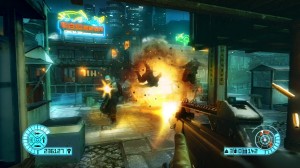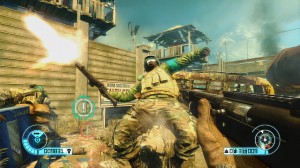Bodycount Review (360)
- Updated: 21st Sep, 2011
 Tesanga! And welcome to Codemaster’s latest FPS. Bodycount is touted as being the game with the realistically destructible environment. Want to hide in a poky little hut and shoot enemies through the wall? You can! Crouch behind an oil drum and try to snipe with a machine pistol? You can! Get stuck to little bits of not fully destructed realistically destructible environment? I did.
Tesanga! And welcome to Codemaster’s latest FPS. Bodycount is touted as being the game with the realistically destructible environment. Want to hide in a poky little hut and shoot enemies through the wall? You can! Crouch behind an oil drum and try to snipe with a machine pistol? You can! Get stuck to little bits of not fully destructed realistically destructible environment? I did.
The action starts off gently with a short tutorial. Aiming, shredding the environment and highlighting that you should be picking up the OSB blobs dropping from your butchered enemies. The OSB mechanic is the first nod to arcade style game play and one with an unexplained acronym at that. This vague grasp on reality and devil may care attitude to explaining what the hell is going on won’t be the last you experience with Bodycount. Ammo quantity, type and special skills are all controlled by the tokens being spunked out as you shoot your way across the maps. I really dislike this method of ammo replenishment. Whilst understanding that it fits in with what Codemasters are terming “arcade action”, to me it actually makes the game less immersive. The rather cheerful little splinking noises they make don’t gel with the gritty feel of the game and seriously detract from pretending that you’re a Network Operative.
 Once you’ve been led out of the starter area, by a mini map and the generic “bossy woman” mission control voice-over, you’re shown how to use grenades and shoved out on to the streets of an African village. Action and enemies follow swiftly and unrelentingly. The pace of the game at this stage is fast, verging on manic, and whilst this works well to create an adrenalin prickling experience it did nothing for me as a gamer. I spent too much of these earlier maps hiding in a not too destructible corner attempting to funnel incoming NPCs. It’s only in the very brief sections with no gunfire that I remembered I should probably breathe. Thankfully the mission objectives are clearly defined using an arrow and distance indicator on your HUD, with occasional story prompts in the form of aforementioned bossy woman issuing directives.
Once you’ve been led out of the starter area, by a mini map and the generic “bossy woman” mission control voice-over, you’re shown how to use grenades and shoved out on to the streets of an African village. Action and enemies follow swiftly and unrelentingly. The pace of the game at this stage is fast, verging on manic, and whilst this works well to create an adrenalin prickling experience it did nothing for me as a gamer. I spent too much of these earlier maps hiding in a not too destructible corner attempting to funnel incoming NPCs. It’s only in the very brief sections with no gunfire that I remembered I should probably breathe. Thankfully the mission objectives are clearly defined using an arrow and distance indicator on your HUD, with occasional story prompts in the form of aforementioned bossy woman issuing directives.
Shifting from village to mine complex to TRON like space-age base, the maps feel large and well spaced out. I enjoyed the level design, which made good use of vertical space and cover. They do keep recycling the same levels, though, which is a shame as I liked the artwork. I also struggled with spotting the enemies against the buildings due to the ubiquitous brownish colour palette. This actually makes some levels a bitch to complete. You’re expected to take on super-baddies dressed in black combat suits whilst running around a black room, relying on a combination of the HUD, incoming tracer rounds and mini-map to work out what direction enemy fire is coming from. This gets old rather quickly. I’m prepared to give this the benefit of the doubt, however, as my telly isn’t especially modern.
 After you’ve destroyed a couple of satellites and a boss, the story takes you through to the super-baddies. It’s at this stage, and rather early on in the game, that I lost track of the plot. ‘The Target’ appear to be up to no good in various locations around the world. They have a plethora of hidden bases all very shiny, made of plate glass and filled with double-hard bastards. These were tenuous at best until the pinnacle of “what the fuck!” moments arrived half way through the game. Out of the ground rises a super-baddy Nexus tower; quite literally a skyscraper shaped base in the middle of some shanty town. The way these Nexus areas are slotted in to the game is ridiculous. Some turn up in derelict buildings, another in a tunnel, and to have towers coming out of the ground a la Dune-worms lost them the final points of my already dwindling respect. Still, the tower doesn’t last long. Having realised that I’ve come to sort them out they blow it in to tiny pieces. It simply smacks of plot being second, possibly even third to guns and killing and actually serves to make me dislike the game for its sheer stupidity.
After you’ve destroyed a couple of satellites and a boss, the story takes you through to the super-baddies. It’s at this stage, and rather early on in the game, that I lost track of the plot. ‘The Target’ appear to be up to no good in various locations around the world. They have a plethora of hidden bases all very shiny, made of plate glass and filled with double-hard bastards. These were tenuous at best until the pinnacle of “what the fuck!” moments arrived half way through the game. Out of the ground rises a super-baddy Nexus tower; quite literally a skyscraper shaped base in the middle of some shanty town. The way these Nexus areas are slotted in to the game is ridiculous. Some turn up in derelict buildings, another in a tunnel, and to have towers coming out of the ground a la Dune-worms lost them the final points of my already dwindling respect. Still, the tower doesn’t last long. Having realised that I’ve come to sort them out they blow it in to tiny pieces. It simply smacks of plot being second, possibly even third to guns and killing and actually serves to make me dislike the game for its sheer stupidity.
The guns are good though and the models are realistic. They sound meaty and feel suitably beefy and, well, gunny. However, aiming can be a bit of a pig, even with the auto aim feature selected, and there’s often more than a little bit of blind luck involved. There are still a couple of issues with the weapons side of the game. Firstly, you can choose two guns and these can only be swapped out for other models when you find one of the weapon caches in the level. They’re not obviously marked up and more than once weren’t on the main path for that map (or if they were I’d sauntered casually past). I understand this being meant to add a degree of tactical decision but mostly it’s simply annoying. The second and, for me, most glaring omission made was the inability to pick up guns dropped by the enemy. Acquisition of stonking weapons hardware is one of the best parts of this genre. Having to wait till you find a weapons cache to see if one has appeared takes a lot of that instant gratification away.
Eventually you wave goodbye to Africa, only to be unceremoniously dumped in the middle of Asia. For the first time in the game fire-fights become almost enjoyable, as the difficulty of the map is less about sheer volume of enemies and more about tactical play. Sadly there’s no such improvement for the AI. It appears continuously away with the fairies, often failing to notice you’ve been stood next to an NPC for a few seconds. Set pieces continue to be littered through the levels and these often become trials of persistence over skill and counting the boss fights amongst these there are just too many. I lost track of the amount of times I watched a General flee across a bridge, got shot and ended up back at a very remote save point.
These later stages see your OSB power-ups start to upgrade. My favourite, the pulse blast, takes out any enemy with a Target chip implanted. Goodbye pointy helmet Target soldiers! There is still a slight niggle for me around the explosive ammo. It seems a bit unrealistic that it counts down on time activated and not bullets used. The management of this OSB resource adds a level of strategy to various fights but I found it was often left unused for periods of time.
 When you get sick of the main campaign several other play options are available. Firstly we have Bodycount mode. Bluntly, I’m not sure why this was included. It seems to exist solely to give you the option to select specific missions to replay to your heart’s content. Secondly, there are the multi-player offerings. I had a go on both the solo and team death match games and was pleasantly surprised. Spawn time is quick and avoids making you spend too much time admiring your corpse. The OSB mechanic is used well here and there are often tough struggles over the areas where they’ve dropped. My only criticism would be the speed at which you die. There is almost zero time to react to being shot with anything remotely approaching a strategy. For a quick fix of shooting people up though it’s worth a go, just don’t necessarily expect to find anyone to shoot. The queue times when I trialled this feature were long, mostly due to a lack of online participants.
When you get sick of the main campaign several other play options are available. Firstly we have Bodycount mode. Bluntly, I’m not sure why this was included. It seems to exist solely to give you the option to select specific missions to replay to your heart’s content. Secondly, there are the multi-player offerings. I had a go on both the solo and team death match games and was pleasantly surprised. Spawn time is quick and avoids making you spend too much time admiring your corpse. The OSB mechanic is used well here and there are often tough struggles over the areas where they’ve dropped. My only criticism would be the speed at which you die. There is almost zero time to react to being shot with anything remotely approaching a strategy. For a quick fix of shooting people up though it’s worth a go, just don’t necessarily expect to find anyone to shoot. The queue times when I trialled this feature were long, mostly due to a lack of online participants.
Summary
Essentially Bodycount isn’t a bad game; it’s just not a good game, falling a little short in almost every area. The ability to destroy the environment doesn’t even partially redeem this release. Gormless AI, frequently frustrating set pieces and the off kilter OSB mechanic make it a chore of a game. Small segments are very well done but unfortunately for Codemasters it’s just not enough.
At the RRP for the 360 version of £49.99 I wouldn’t even give it a look. It’s available online closer to the £25.00 mark but even that’s a stretch. If you don’t mind enduring what’s essentially a clumsy FPS for the chance to go ape shit at scenery and racially stereotyped enemies you’re golden. Otherwise, I’d give it a miss.


Follow Us!